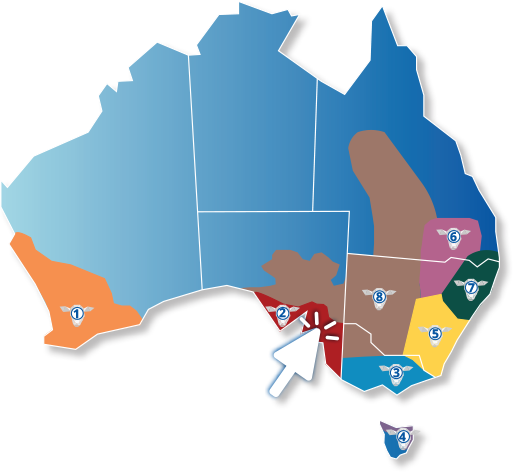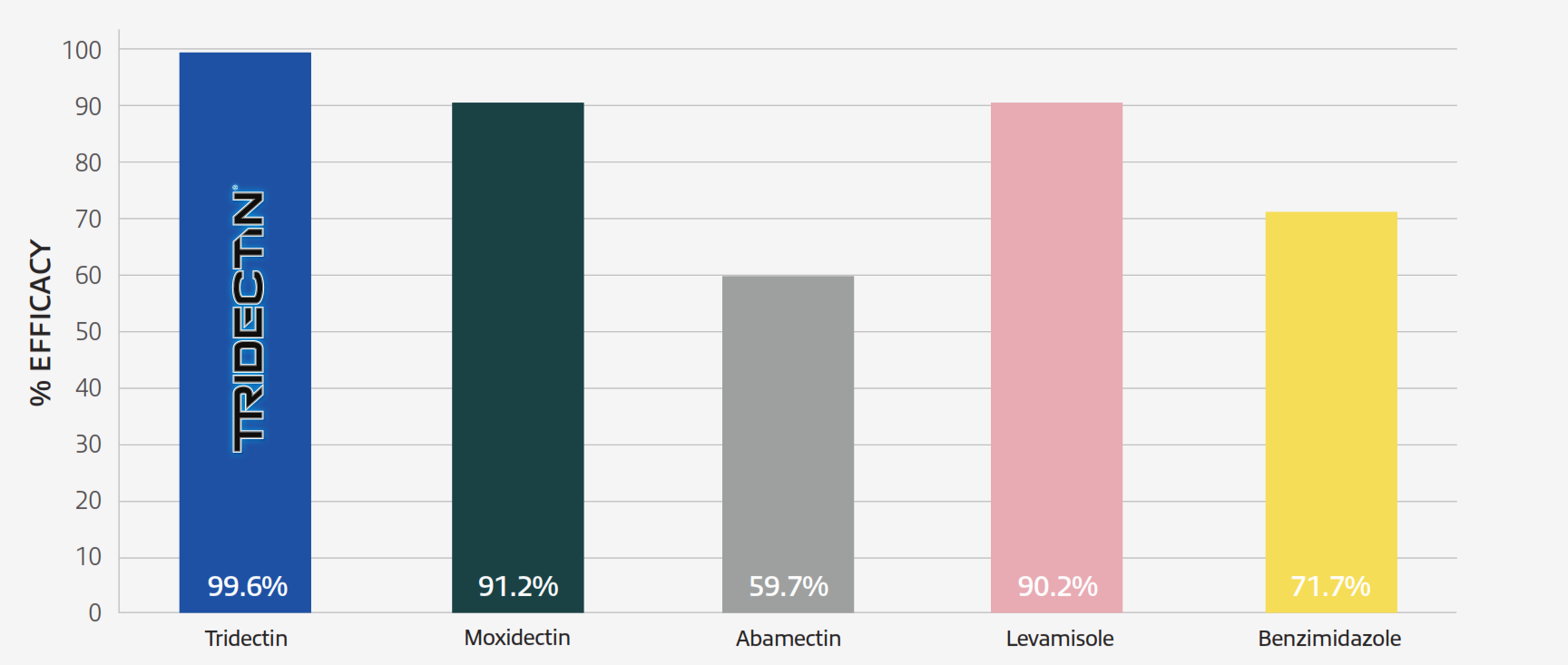Get results today!
See how effective Tridectin® is in your area. We have the most recent results from over 130 tests conducted.
Power up your drench program with Tridectin®
Tridectin® is one of the most powerful tools for worm control.
- Unique Moxidectin triple-active offers 97% average efficacy
- More effective than most other drench combinations3
- Persistent activity for 14 days3 providing better control of Barber’s pole worm and Small brown stomach worm
- Highly flexible: can be used for drenching at any time of the year
- 7-day meat WHP and 17 day ESI4 offer optimal market opportunities
ABC Transporters and Macrocyclic Lactones
Learn how Abamectin and Moxidectin interact with ABC transporters and how this relationship influences drench efficacy.
Welcome to the Tridectin “How to Get Cleaner Pastures” Calculator
Have you just checked the drench efficacy in your region using this Tridectin portal?
Are you now wondering what the actual impact on your property is?
Download the calculator below and find out!
-
Control resistance by using effective drenches
Resistance is increasing all over Australia and reduces the profitability of sheep farms. Virbac continues to assist producers to do faecal egg count reduction tests (FECRTs) nationally.
FECRTs confirm each drench’s effectiveness for each worm type present. It is the most accurate way to test for drench resistance. A drench is considered effective if it reduces the worm egg count (WEC) by 95% or more.
Because worm populations and challenge levels differ between geographical areas, FECRTs have been collected across the whole country. The national results are reported on this page.
Most recent FERCT data
Our data has been collected over the past 4 years, making it the most recent data available to Australian farmers1. It reflects the resistance situation in the field in the most precise way, whilst older data might not give an accurate picture of resistance status. Our new data helps to select the right drench for each property – a drench with the most recent proven efficacy.
Nevertheless, since resistance status on each farm might vary, drench tests should be repeated every 3 to 5 years on each farm to ensure that the right actives are chosen for drenching.
-
We are helping to make your drench decision easy
New data proves – Tridectin® 3 Way Oral Drench for Sheep offers:
Outstanding efficacy*
- Offers 97% overall efficacy1
- Better efficacy compared to Abamectin Triples and Closantel combinations1
- More effective against Barber’s pole worm than Closantel combinations1
- Controls Abamectin triple-resistant and monepantel resistant worms3
- Same or better efficacy as Monepantel/Derquantel combinations1
* Average efficacy
Convenient and flexible drenching
- Can be used for ewes**, lambs, and rams at any time of the year
- Offers high flexibility through very short withholding periods
- WHP Meat – 7 days4
- ESI – 17 days4
- Improves marketing options for your sheep
** MILK: DO NOT USE in sheep which are producing or may in the future produce milk or milk products for human consumption.
Strong persistent activity against Barber’s pole worm and Small brown stomach worm
- Tridectin(R) is the only three way combination drench that offers persistent activity against Barber’s pole worm and Small brown stomach worm for 14 days4
- Significantly reduces infection pressure meaning less contaminated pastures, which offers a strong control of Barber’s pole worm, even in heavily infested regions
Sustainable worm control with Moxidectin
- Widespread use of Abamectin-based products has resulted in a massive increase in Abamectin resistance
Australian made
- Virbac is one of the few companies that manufacture sheep and cattle drenches and vaccines in Australia
- Virbac supports the Australian economy and your business
Protects our environment
- Moxidectin has no known impact on dung beetles
Tridectin’s excellent efficacy against today’s worms (98%) has also been confirmed by independent research, published by Australian Wool Innovation (AWI) in 2020.
Click here to find out more.
-
Check your drench efficacy on national level (averages) and see how Tridectin® outperformed most other drench combinations:
Show Results
Moxidectin
Select
+ White
+ Clear Drench
– Tridectin®Monepantel
SelectDerquantel
Select
& AbamectinAbamectin
Select
+ White
+ Clear Drench
(Aba-Triple)Abamectin
Select
+ White
+ Clear Drench
+ ClosantelAbamectin
SelectMoxidectin Long
Select
Acting InjectionMoxidectin Oral
SelectMonepantel
Select
& AbamectinClear Drench
SelectNaphthalophos
SelectWhite Drench
SelectClear + White
Select
DrenchClosantel
SelectNaphthalophos
Select
+ White DrenchNaphthalophos
Select
+ Clear
+ White DrenchNaphthalophos
Select
+ Clear DrenchAbamectin
Select
+ ClosantelMoxidectin
+ White
+ Clear DrenchMonepantel
Derquantel
& AbamectinAbamectin
+ White
+ Clear Drench
(Aba-Triple)Abamectin
+ White
+ Clear Drench
+ ClosantelAbamectin
Moxidectin
+ White
+ Clear DrenchMonepantel
Derquantel
& AbamectinAbamectin
+ White
+ Clear Drench
(Aba-Triple)Abamectin
+ White
+ Clear Drench
+ ClosantelAbamectin
NT = NOT TESTEDBroad spectrum
Overall National Efficacy Rates
NT = NOT TESTEDBarber’s Pole Worm
National Efficacy Rates
NT = NOT TESTEDBlack scour worm
National Efficacy Rates
NT = NOT TESTEDSmall brown stomach worm
National Efficacy Rates
NT = NOT TESTEDOther worms
National Efficacy Rates
Because worm populations and challenge levels differ between geographical areas, FECRTs have been collected across the whole country.
Check your drench efficacy on national averages and see how Tridectin® outperformed most other drench combinations.
Follow these three simple steps to compare drench efficacy data in your region:
Step One – select your region
Step Two – select your drenches to compare
The drenches in grey are selected by default. Replace them with your drenches of interest by clicking on them and clicking on your drenches.
Step Three – compare drench efficacy
















- 1 - Western Australia Winter Rainfall
- 2 - South Australian Winter Rainfall
- 3 - Victorian Winter Rainfall
- 4 - Tasmania
- 5 - NSW Non-Seasonal Rainfall
- 6 - Qld/NSW Summer Rainfall/Slopes & Plains
- 7 - Qld/NSW Summer Rainfall/Tablelands & Slopes
- 8 - Pastoral Region
Western Australian Winter Rainfall
The South-West Medium to High Rainfall Zone
This includes the corner of the state, south-west of the 350 mm rainfall isohyet. It starts at the coast a little north of Kalbarri, continues west of Mullewa and Perenjori, then includes Cadoux, Quairading, Corrigin, Lake Grace, Ravensthorpe, and Esperance near its eastern or northern edge.
Sheep are a more important part of the farming enterprise than in districts to the east, and both the total rainfall and seasonal duration (months of rainfall) is greater in this zone. Conditions for worm burden development are therefore more favourable than in drier areas.
There is a large variation between districts in this zone in the annual risk of significant worm problems due to rainfall differences, although the basic control plan is applicable. The worm risk is lower east of the 500 mm isohyet, where there is usually a shorter pasture growth season and a greater area of the farm is under crop.
Closer to the coast within the zone the rainfall is considerably higher, and pastures often retain a green component over summer (a barber’s pole worm risk). Along the south coast and west of Bremer Bay, and in a coastal zone along the west coast as far as Geraldton, the rainfall is both greater and of longer seasonal duration, further increasing the likelihood and duration of the worm risk.
The Low Rainfall Cereal Zone
This zone is east of the 350 mm isohyet, extending to the border of the Pastoral Zone of the state and includes Mullewa, Wubin, Bullfinch, Southern Cross, Merredin, Hyden and Lake King. In these areas the summers are hot and the effective rainfall is relatively low. As cropping is the dominant enterprise, the large areas of crop stubbles provide significant opportunities to avoid worm intake. The worm risk is therefore low in most years, and especially in eastern areas of the zone, visible signs of worms are only occasionally seen after unusually heavy summer rainfall.
South Australian Winter Rainfall
The South-East zone
This zone is the south-eastern corner of the state below an approximate line running from Kingston SE to Bordertown, through to the Victorian border. The zone generally receives more than 550 mm annual rainfall. Although summers are warm, effective summer rainfall episodes (12mm or more) are not unusual, especially towards the coast. Pastures sometimes retain a substantial green component over summer.
The Higher Rainfall Mediterranean zone
This zone has the following areas:
- Kangaroo Island
- The southern tip of the Eyre Peninsula below Cummins
- Fleurieu Peninsula and the Adelaide Hills
- Clare Valley
Usually this zone receives more than 450 mm rainfall per year (though some areas are substantially higher) and summers are generally hot with no effective rainfall. Cropping can be a component of the enterprise mix.
The Lower Rainfall Mediterranean zone
This zone is north of the Higher Rainfall Mediterranean zone and extends to a line running from Ceduna across the Eyre Peninsula to between Cowell and Whyalla, then from around Port Pirie to south of Port Augusta, Orroroo and Peterborough, then east or north of Burra, Mannum, Karoonda to near Pinnaroo. This corresponds to Goyder’s line in many places.
Victorian Winter Rainfall
The area covers most of Victoria except for the drier north-western area (Mallee and northern Wimmera) to the north or west of Kaniva, Warracknabeal, Charlton and Cohuna. This area is in the WormBoss Pastoral region.
The more uniform- and summer-dominant rainfall areas of East Gippsland may also find the WormBoss NSW non-seasonal rainfall program a useful reference.
Tasmania
The Tasmanian high rainfall (prime-lamb) region
This region includes King Island, the North Coast between Wynyard and Launceston. These are the high winter rainfall areas with up to 1200 mm annually.
The Tasmanian medium to low rainfall (extensive) region
This region includes the north-east coast, the Midlands and Derwent Valley and the lower east coast. The rainfall is non-seasonal, between 350 and 600 mm annually.
The Tasmanian summer rainfall region
This region includes Flinders Island and in some years, the north-east coast. The medium to low rainfall region recommendations apply here, but the summer rainfall also predisposes to barber’s pole worms. Also, other areas in Tasmania with sheep on irrigated summer pastures may experience barber’s pole worm burdens in late summer and early autumn.
These boundaries are approximations only as seasonal temperature and rainfall variations affect worms.
NSW Non-Seasonal Rainfall
The south western area (including the eastern Riverina) with hot summers and cool winters (includes the towns of Condobolin, West Wyalong, and Wagga Wagga).
The tablelands area with warm summers and cold frosty winters (includes the towns of Bathurst, Orange, Yass, Young, Goulburn, Cooma); and
The coastal area with warm to hot summers that are more humid and cool winters (includes the towns of Bega, Batemans Bay).
The eastern Riverina (includes the towns of Finlay, Narrandera and Griffith, Lockhart and Corowa) with hot summers and more winter rainfall dominance.
The region extends from an east-west line through Warren in the north to the NSW/Victoria border and west from the coast to a line from Nymagee (west of Nyngan and Tottenham) through to the Victorian border just west of Finlay.
Qld/NSW Summer Rainfall/Slopes and Plains
The southern and northern boundaries are lines running east-west through Warren, New South Wales and through Roma, Queensland, respectively. The eastern boundary runs north from Gilgandra (NSW) to Siding Springs just west of Coonabarabran, then through Narrabri, Yetman and Texas, then south of Warwick, and then along the range north to Kingaroy (Qld). The western border goes from Mitchell (Qld) in the north, to Bollon, Goodooga, and Brewarrina, ending between Nyngan and Cobar (NSW) in the south.
Other towns in this zone are Walgett, Coonamble, Wee Waa, Moree, Mungindi, Dirranbandi, St George, Goondiwindi, Inglewood, Moonee, Surat, Millmerran, Chinchilla, Dalby and Toowoomba.
Qld/NSW Summer Rainfall/Tablelands and Slopes
Mudgee, Dunedoo, Merriwa, Coolah, Tamworth, Coonabarabran, Narrabri, Gunnedah, Manilla, Barraba, Bingara, Bundarra, Inverell, Warialda, Walcha, Bendemeer, Uralla, Armidale, Guyra, Glen Innes, Tenterfield, Texas and Stanthorpe. Coastal towns included are Murwillumbah, Lismore, Grafton, Coffs Harbour, Port Macquarie, Muswellbrook, Maitland and their hinterland areas.
Pastoral Region
Queensland: north and west of Mitchell, and west of the Great Dividing Range to Hughenden, then west to Julia Creek, then south including Longreach and Charleville, and just including Windorah, Eromanga and Thargomindah in the south-west.
New South Wales: west of the following towns Goodooga, Nyngan, Lake Cargelligo, Griffith and Finley.
Victoria: north and west of an approximate line from Swan Hill across to Kaniva.
South Australia: north of Goyder’s line to the dingo fence.




